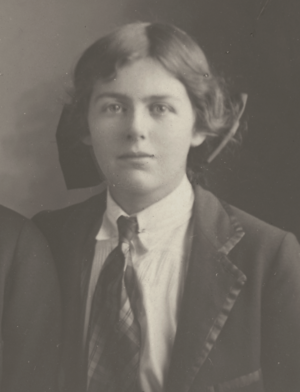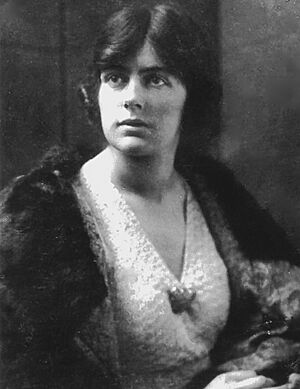Joan Lindsay facts for kids
Quick facts for kids
Joan Lindsay
|
|
|---|---|
 |
|
| Born | Joan à Beckett Weigall 16 November 1896 St Kilda East, Victoria, Australia |
| Died | 23 December 1984 (aged 88) Frankston, Victoria, Australia |
| Pen name | Serena Livingstone-Stanley |
| Occupation | |
| Alma mater | National Gallery of Victoria Art School |
| Genre | Satire, autobiography, Gothic |
| Spouse |
Sir Ernest Daryl Lindsay
(m. 1922; |
| Signature | |
 |
|
Joan à Beckett Weigall, Lady Lindsay (born November 16, 1896 – died December 23, 1984) was an Australian writer and artist. She wrote novels, plays, and essays. She also created visual art.
Joan Lindsay first trained as a painter. She published her first book in 1936 when she was 40. It was a funny story called Through Darkest Pondelayo. She used a fake name, called a pseudonym, for this book. Her second novel, Time Without Clocks, came out almost 30 years later. This book was partly about her own life and her early marriage to artist Sir Daryl Lindsay.
In 1967, Lindsay published her most famous book, Picnic at Hanging Rock. This historical Gothic novel tells the story of three schoolgirls and their teacher who disappear. They vanish during a summer picnic at a large rock formation. The book became very popular because it felt like a true story. It also had a mysterious ending. Many people think it is one of the most important Australian novels. It was later made into a movie in 1975.
Joan Lindsay also wrote several plays that were not published. She wrote essays, short stories, and poems for many different magazines. After her husband died in 1976, she became very active in the art world in Melbourne. Her last published book, Syd Sixpence (1982), was her only book for children. Lindsay died in 1984. Her home was given to the Australian National Trust. It is now a museum that shows her and her husband Daryl's art and personal items.
Contents
Life and Career of Joan Lindsay
Early Life and Education
Joan à Beckett Weigall was born in St Kilda East, a suburb of Melbourne, Australia. She was the third daughter of Theyre à Beckett Weigall, a well-known judge. Her mother, Ann Sophie Weigall, was a musician from Dublin. Joan had two sisters, Mim and Nancy, and a brother, Theyre Jr. She grew up in a large house called "St Margaret's." She said her childhood was "outwardly happy and uneventful."
In 1909, when Joan was 13, she went to a local boarding school called Carhue. The school later changed its name to the Clyde Girls' Grammar School. Joan was a very good student. After finishing school, she thought about becoming an architect. Instead, she decided to study art. In 1916, she joined the National Gallery of Victoria Art School in Melbourne. There, she studied painting with teachers like Bernard Hall and Frederick McCubbin.
In 1920, she shared an art studio in Melbourne with Maie Ryan. Joan showed her paintings at two exhibitions in Melbourne that year. She also worked with Maie Casey on a book called Portrait of Anna, but it was never finished.
Marriage and Early Writing
While studying art, Joan met another art student named Daryl Lindsay. They got married in Marylebone, London, England, on St. Valentine's Day in 1922. Valentine's Day was always special to Joan. She even set her most famous book, Picnic at Hanging Rock, on that day.
When Joan and Daryl returned to Australia, they fixed up a farmhouse in Baxter. It was called Mulberry Hill. They lived there until the Great Depression made things difficult. They had to rent out their home and move to a smaller place. During this time, Joan started focusing more on writing instead of painting. She wrote two plays, Cataract and Wolf!. Wolf! was written with Margot Goyder and Ann Joske, who were famous detective story writers. Neither play was published, but Wolf! was performed in England in 1930.
After traveling in England and Europe, Lindsay published her first novel in 1936. It was called Through Darkest Pondelayo: An account of the adventures of two English ladies on a cannibal island. She used the pseudonym Serena Livingstone-Stanley. The book made fun of popular travel books of the time. It also made fun of English tourists.
Lindsay also wrote articles, reviews, and stories for different magazines and newspapers. She wrote about art, literature, and famous people. In 1941, she helped her husband Daryl write the History of the Australian Red Cross. In 1942, she wrote an essay about the novelist George Moore.
During this time, Daryl Lindsay stopped painting. He became the Director of the National Gallery of Victoria from 1942 to 1955. This meant they had to move to Melbourne. When Daryl was made a knight in 1956, Joan became known as Lady Lindsay.
Her novel Time Without Clocks is partly about her own life. It describes her wedding and happy early married life. The book's title comes from a strange ability Joan said she had. She could make clocks and machines stop when she was near them. The title also suggests that this time in her life felt free and unstructured. She then wrote Facts Soft and Hard. This was a funny, partly true story about the Lindsays' travels in the United States.
The Success of Picnic at Hanging Rock
Picnic at Hanging Rock, published in 1967, is Joan Lindsay's most famous book. Lindsay wrote the novel in just four weeks at her home, Mulberry Hill. She based the story around the real Hanging Rock, a large rock formation that had interested her since she was a child.
The novel is historical fiction. However, Lindsay hinted that it was based on a real event. The book's introduction even suggests this. Lindsay had written an ending that explained what happened to the girls. But her publisher decided to remove it before the book was printed. This final chapter was published later, in 1987, as a separate book called The Secret of Hanging Rock. It also included ideas and theories about the novel. Lindsay based Appleyard College, the school in the novel, on her own school, Clyde Girls Grammar School. This school later moved close to Hanging Rock.
The book's mysterious ending made many readers and critics very interested. The novel has been compared to the works of writers like E.M. Forster and Nathaniel Hawthorne. In 1975, the book was made into a movie. This film, directed by Peter Weir, helped start a new wave of Australian cinema. When the novel was reprinted in 1975, it sold over 350,000 copies in Australia. This made it Penguin Australia's best-selling novel at the time.
Later Life and Legacy
In 1969, Lindsay was badly hurt in a car accident. She needed many months to recover. Daryl Lindsay, her husband, died on Christmas Day 1976. In her later years, Lady Lindsay focused on visual arts. She often visited art clubs and galleries in Melbourne. She was very involved in the local art community. She painted several works in her later years. Art critics praised her work.
In 1972, she met up with Lady Maie Casey again. They held an art exhibition together. Artist Rick Amor and his children lived in a cottage on Lindsay's property. This led her to bring back an unpublished children's book she had written. It was called Syd Sixpence, and she published it in 1982. Rick Amor drew the pictures for the book. It tells the story of Syd, a sixpence coin that comes to life and has adventures on the ocean floor. Lindsay also worked on another novel, Love at the Billabong, but she did not finish it.
Joan Lindsay died from stomach cancer in Frankston, Melbourne, on December 23, 1984. She was 88 years old. She was cremated, and her ashes are buried in Creswick Cemetery in Victoria, Australia. Joan and Daryl Lindsay did not have any children. So, their home, Mulberry Hill, was given to the National Trust after her death. The Mulberry Hill estate is now open to the public. It displays Joan and Daryl Lindsay's original artwork and personal belongings.
Lindsay's visual artwork has been shown in art exhibitions in Australia even after her death.
See also
 In Spanish: Joan Lindsay para niños
In Spanish: Joan Lindsay para niños
- Tasmanian Gothic
- Hanging Rock, Victoria



